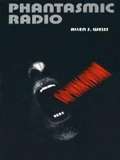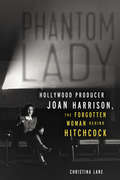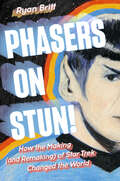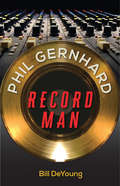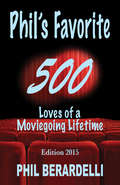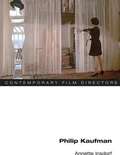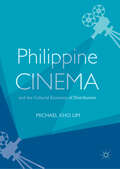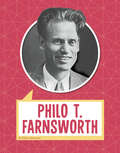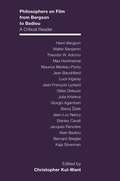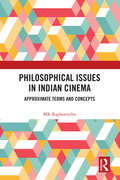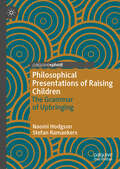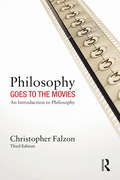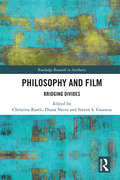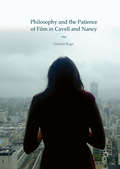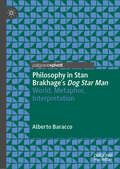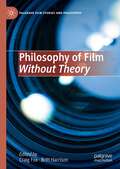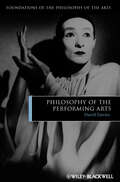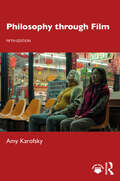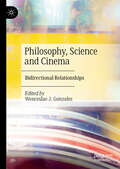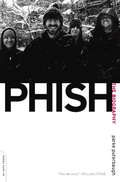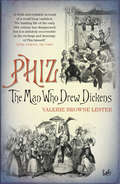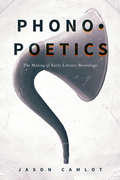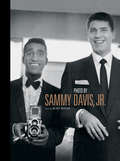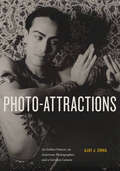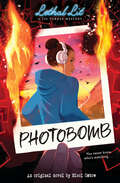- Table View
- List View
Phantasmic Radio
by Allen S. WeissThe alienation of the self, the annihilation of the body, the fracturing, dispersal, and reconstruction of the disembodied voice: the themes of modernism, even of modern consciousness, occur as a matter of course in the phantasmic realm of radio. In this original work of cultural criticism, Allen S. Weiss explores the meaning of radio to the modern imagination. Weaving together cultural and technological history, aesthetic analysis, and epistemological reflection, his investigation reveals how radiophony transforms expression and, in doing so, calls into question assumptions about language and being, body and voice.Phantasmic Radio presents a new perspective on the avant-garde radio experiments of Antonin Artaud and John Cage, and brings to light fascinating, lesser-known work by, among others, Valère Novarina, Gregory Whitehead, and Christof Migone. Weiss shows how Artaud's "body without organs" establishes the closure of the flesh after the death of God; how Cage's "imaginary landscapes" proffer the indissociability of techne and psyche; how Novarina reinvents the body through the word in his "theater of the ears." Going beyond the art historical context of these experiments, Weiss describes how, with their emphasis on montage and networks of transmission, they marked out the coordinates of modernism and prefigured what we now recognize as the postmodern.
Phantom Lady: Hollywood Producer Joan Harrison, the Forgotten Woman Behind Hitchcock
by Christina LaneIn 1933, Joan Harrison was a twenty-six-year-old former salesgirl with a dream of escaping both her stodgy London suburb and the dreadful prospect of settling down with one of the local boys. A few short years later, she was Alfred Hitchcock's confidante and one of the Oscar-nominated screenwriters of his first American film, Rebecca. Harrison had quickly grown from being the worst secretary Hitchcock ever had to one of his closest collaborators, critically shaping his brand as the "Master of Suspense." Forging her own public persona as the female Hitchcock, Harrison went on to produce numerous Hollywood features before becoming a television pioneer as the producer of Alfred Hitchcock Presents. A respected powerhouse, she acquired a singular reputation for running amazingly smooth productions— and defying anyone who posed an obstacle. She built most of her films and series from the ground up. She waged rough-and-tumble battles against executives and censors, and even helped to break the Hollywood blacklist. She teamed up with many of the most respected, well-known directors, writers, and actors of the twentieth century. And she did it all on her own terms. Author Christina Lane shows how this stylish, stunning woman became Hollywood's most powerful female writer-producer—one whom history has since overlooked.
Phasers on Stun!: How the Making (and Remaking) of Star Trek Changed the World
by Ryan BrittWritten with inside access, comprehensive research, and a down-to-earth perspective, Phasers on Stun! chronicles the entire history of Star Trek, revealing that its enduring place in pop culture is all thanks to innovative pivots and radical change. For over five decades, the heart of Star Trek&’s pro-science, anti-racist, and inclusive messaging has been its willingness to take big risks. Across thirteen feature films, and twelve TV series—including five shows currently airing or in production—the brilliance of Star Trek is in its endless ability to be rethought, rebooted, and remade. Author and Star Trek expert Ryan Britt charts an approachable and entertaining course through Star Trek history; from its groundbreaking origins amid the tumultuous 1960s, to its influence on diversifying the space program, to its contemporary history-making turns with LGBTQ+ representation, this book illuminates not just the behind-the-scenes stories that shaped the franchise but the larger meaning of the Final Frontier. Featuring over 100 exclusive interviews with actors and writers across all the generations, including Walter Koenig, LeVar Burton, Dorothy Fontana, Brent Spiner, Ronald D. Moore, Jeri Ryan, and many more, Britt gets the inside story on all things Trek, like Spock&’s evolution from red devil to the personification of logical empathy, the near failure to launch of The Next Generation in 1987, and how Trekkie outrage has threatened to destroy the franchise more than once. The book also dives deep with creators like Michael Chabon (co-creator of Star Trek: Picard) and Nicholas Meyer (director, The Wrath of Khan). These interviews extend to the bleeding edge of contemporary Star Trek, from Discovery to Picard to Lower Decks, and even the upcoming highly anticipated 2022 series, Strange New Worlds. For fans who know every detail of each Enterprise bridge, to a reader who has never seen a single minute of any Star Trek, this book aims to entertain, inform, and energize. Through humor, insight, archival research, and unique access, this journey through the Star Trek universe isn&’t just about its past but a definitive look at its future.
Phil Gernhard, Record Man
by Bill DeYoungA go-getting, red-headed college kid eager to break into the music business, Phil Gernhard produced a handful of singles for South Carolina doo-wop group Maurice Williams and the Zodiacs. One of these songs, "Stay," reached number one on the charts in 1960. Gernhard was just 19 years old. Phil Gernhard, Record Man is the story of a self-made music mogul who created nearly fifty years' worth of chart-topping songs. From a tiny office and studio in Florida, he co-wrote the Royal Guardsmen's "Snoopy vs. the Red Baron," America's fastest-selling single of 1966. He revived the career of singer Dion DiMucci with the ballad "Abraham, Martin and John"--a million seller. He discovered and produced hit records for Lobo, Jim Stafford, and the Bellamy Brothers. Through a long collaboration with music business icon Mike Curb, he launched to fame many others, including country superstars Tim McGraw and Rodney Atkins. In Nashville and Los Angeles, Phil Gernhard was a legend. Yet Gernhard's private life was crumbling. He battled physical and emotional demons that he simply couldn't overcome, struggling with alcoholism, drug addiction, and a bad past with his father. He filed for his fourth divorce just months before taking his own life in 2008. Through interviews with Gernhard's musicians, business partners, family members, and ex-wives, Bill DeYoung offers an intimate portrait of a brilliant yet troubled man who channeled his talent, ego, and ambition into the success of others. A true "record man," Gernhard did it all. He lived to make records into gold, to make unknowns into stars, and above all, to make music.
Phil's Favorite 500: Loves of a Moviegoing Lifetime
by Phil BerardelliPhil Berardelli has been in love with movies ever since his first encounter as a little boy thrilled him and then scared the daylights out of him. In the intervening years, including a six-year stint as a TV movie critic, Phil has seen at least 5,000 titles. Here he has put together a list of his 500+ favorites, which he has separated into 50 categories. He has accompanied each one with informative, witty, and often insightful capsule comments along with bits of trivia, formatting descriptions and, where available, links to online trailers, clips and full-length versions. Newly updated for 2014 and containing 24 new titles -- plus a new section of recommended books -- Phil's Favorite 500 encompasses everything Phil has learned in over half a century of moviegoing. The list includes something for everyone -- adults, couples, children, teens and families -- and covers some of the greatest movies ever made, both in the U.S. and elsewhere, as well as some of the cinema's most entertaining clunkers. Many of his choices -- and omissions -- may surprise you. But in all cases, Phil makes compelling arguments for sampling these titles. If you do sample them, you might just find yourself adding many of them to your own list of favorites. Sampled, browsed, or read from beginning to end, Phil's Favorite 500 reflects a love of the medium that is contagious, and his descriptions will help you view even the most familiar movies in a new and very entertaining way.
Philip Kaufman (Contemporary Film Directors)
by Annette InsdorfAmerican director Philip Kaufman is hard to pin down: a visual stylist who is truly literate, a San Franciscan who often makes European films, he is an accessible storyteller with a sophisticated touch. Celebrated for his vigorous, sexy, and reflective cinema, Kaufman is best known for his masterpiece The Unbearable Lightness of Being and the astronaut saga The Right Stuff. His latest film, Hemingway & Gellhorn(premiering May 2012 on HBO), stars Nicole Kidman and Clive Owen. In this study, Annette Insdorf argues that the stylistic and philosophical richness of Kaufman's cinema makes him a versatile auteur. She demonstrates Kaufman's skill at adaptation, how he finds the precise cinematic device for a story drawn from seemingly unadaptable sources, and how his eye translates the authorial voice from books that serve as inspiration for his films. Closely analyzing his movies to date (including Invasion of the Body Snatchers, The Wanderers, and Quills), Insdorf links them by exploring the recurring and resonant themes of sensuality, artistic creation, codes of honor, and freedom from manipulation. While there is no overarching label or bold signature that can be applied to his oeuvre, she illustrates the consistency of themes, techniques, images, and concerns that permeates all of Kaufman's works.
Philippine Cinema and the Cultural Economy of Distribution
by Michael Kho LimThis book explores the complex interplay of culture and economics in the context of Philippine cinema. It delves into the tension, interaction, and shifting movements between mainstream and independent filmmaking, examines the film distribution and exhibition systems, and investigates how existing business practices affect the sustainability of the independent sector. This book addresses the lack or absence of Asian representation in film distribution literature by supplying the much-needed Asian context and case study. It also advances the discourse of film distribution economy by expounding on the formal and semi-formal film distribution practices in a developing Asian country like the Philippines, where the thriving piracy culture is considered as ‘normal,’ and which is commonly depicted and discussed in existing literature. As such, this will be the first book that looks into the specifics of the Philippine film distribution and exhibition system and provides a historical grounding of its practices.
Philo T. Farnsworth (Biographies)
by Ellen LabrecqueHow much do you know about Philo T. Farnsworth? Find out the facts you need to know about this inventor, scientist, and TV pioneer. You’ll learn about the early life, challenges, and major accomplishments of this important American.
Philosophers on Film from Bergson to Badiou: A Critical Reader
by Christopher Kul-WantPhilosophers on Film from Bergson to Badiou is an anthology of writings on cinema and film by many of the major thinkers in continental philosophy. The book presents a selection of fundamental texts, each accompanied by an introduction and exposition by the editor, Christopher Kul-Want, that places the philosophers within a historical and intellectual framework of aesthetic and social thought.Encompassing a range of intellectual traditions—Marxism, phenomenology, psychoanalysis, poststructuralism, gender and affect theories—this critical reader features writings by Bergson, Benjamin, Adorno and Horkheimer, Merleau-Ponty, Baudrillard, Irigaray, Lyotard, Deleuze, Kristeva, Agamben, Žižek, Nancy, Cavell, Rancière, Badiou, Stiegler, and Silverman. Many of the texts discuss cinema as a mass medium; others develop phenomenological analyses of particular films. Reflecting upon the potential of films to challenge dominant forms of ideology, the anthology considers the ways in which they can disrupt the clichés of capitalist images and offer radical possibilities for creating new worlds of visceral experience outside the grasp of habitual forms of knowledge and subjectivity. Ranging from the early silent period of cinema through the classics of European and Hollywood cinema to the early twenty-first century, the films discussed offer a vivid sense of these philosophers’ concepts and ideas, casting new light on the history of cinema. This reader is an essential and valuable resource for a wide range of courses in film and philosophy.
Philosophical Issues in Indian Cinema: Approximate Terms and Concepts
by MK RaghavendraThis book interrogates the vocabulary used in theorizing about Indian cinema to reach into the deeper cultural meanings of philosophies and traditions from which it derives its influences. It re-examines terms and concepts used in film criticism and contextualizes them within the aesthetics, poetics and politics of Indian cinema. The book looks at terms and concepts borrowed from the scholarship on American and world cinema and explores their use and relevance in describing the characteristics and evolution of cinema in India. It highlights how realism, romance and melodrama in the context of India appear in a culturally singular way and how the aggregation of constituent elements – like songs, action, comedy – in Indian film can be traced to classical theatre and other diverse religious and philosophical influences. These influences have characterized popular film and drama in India which present all aspects of life for a diverse nation. The author explores concepts like ‘fantasy’, ‘family’ and ‘patriotism’ by using various examples from films in India and outside, as well as practices in the other arts. He identifies the fundamental logic behind the choices made by film-makers in India and discusses concepts which allow for a fresh theorizing on Indian cinema’s characteristics. This book will be of great interest to students and researchers of film studies, media studies, cultural studies, literature, cultural history and South Asian studies. It will also be useful for general readers who are interested in learning more about Indian cinema, its forms, origins and influences.
Philosophical Presentations of Raising Children: The Grammar of Upbringing
by Naomi Hodgson Stefan RamaekersThis book uses contemporary film to articulate a philosophical account of raising children. It forms part of a revaluation of the parent as a pedagogical figure, which stands in contrast to the instrumental accounts dominant in contemporary ‘parenting’ culture. Hodgson and Ramaekers use film in order to offer an affirmative account of the experience of raising children, as a presentation of those inevitable aspects and experiences that upbringing is: the initiation into language and the world; the representative nature of the parent; and the maintaining of mundane practices that constitute our shared culture and community. The films which are discussed are taken as grammatical investigations and enable the authors to develop an account of the use of film in education and as educational philosophy, and to respond to each film’s invitation to articulate the existential dimensions of raising children. Philosophical Presentations of Raising Children will be of interest to students and scholars across a range of disciplines, including education, sociology, philosophy, critical parenting studies and film studies.
Philosophy Goes to the Movies: An Introduction to Philosophy
by Christopher FalzonNow emulated in several competing publications, but still unsurpassed in clarity and insight, Philosophy Goes to the Movies: An Introduction to Philosophy, Third Edition builds on the approach that made the two earlier editions so successful. Drawing on many popular and some lesser known films from around the world, Christopher Falzon introduces students to key areas in philosophy, like: • Ethics • Social and Political Philosophy • The Theory of Knowledge • The Self and Personal Identity • Critical Thinking Perfect for beginners, this book guides the reader through philosophy using illuminating cinematic works, like Avatar, Inception, Fight Club, Wings of Desire, Run Lola Run, A Clockwork Orange, Blade Runner, Dirty Harry and many other films. The fully revised and updated Third Edition features: an expanded introduction that provides a new discussion of the relationship between film and philosophy; new material on notable philosophers such as Aristotle, Merleau-Ponty and Rawls; and coverage of new topics like virtue ethics and what Socrates offers for critical thinking. An updated glossary, references and bibliography, and a filmography, are also included in the Third Edition.
Philosophy and Film: Bridging Divides (Routledge Research in Aesthetics)
by Christina Rawls Diana Neiva Steven S. GouveiaThis volume collects twenty original essays on the philosophy of film. It uniquely brings together scholars working across a range of philosophical traditions and academic disciplines to broaden and advance debates on film and philosophy. The book includes contributions from a number of prominent philosophers of film including Noël Carroll, Chris Falzon, Deborah Knight, Paisley Livingston, Robert Sinnerbrink, Malcolm Turvey, and Thomas Wartenberg. While the topics explored by the contributors are diverse, there are a number of thematic threads that connect them. Overall, the book seeks to bridge analytic and continental approaches to philosophy of film in fruitful ways. Moving to the individual essays, the first two sections offer novel takes on the philosophical value and the nature of film. The next section focuses on the film-as-philosophy debate. Section IV covers cinematic experience, while Section V includes interpretations of individual films that touch on questions of artificial intelligence, race and film, and cinema’s biopolitical potential. Finally, the last section proposes new avenues for future research on the moving image beyond film. This book will appeal to a broad range of scholars working in film studies, theory, and philosophy.
Philosophy and the Patience of Film in Cavell and Nancy
by Daniele RugoPhilosophy and the Patience of Film presents a comparative study of the work of Jean-Luc Nancy and Stanley Cavell. It discusses the effect of their philosophical engagement with film, and proposes that the interaction between philosophy and film produces a power of patience capable of turning our negation of the world into a relation with it. Through detailed readings of cinematic works ranging from Hollywood classics to contemporary Iranian cinema, this book describes the interaction between film and philosophy as a productive friction from which the concept of patience emerges as a demand for thinking. Daniele Rugo explains how Nancy and Cavell's relationship with film demands the surrendering of philosophical mastery, and that it is precisely this act in view of the world that brings Cavell and Nancy to the study of film. While clarifying the nature of their engagement with film this book suggests that film does not represent the world, but 'realizes' it. This realization provides a scene of instruction for philosophy. Foreword by Jean-Luc Nancy, Distinguished Professor of Philosophy, Université Marc Bloch, Strasbourg.
Philosophy in Stan Brakhage's Dog Star Man: World, Metaphor, Interpretation
by Alberto BaraccoThis book shows how a masterpiece of experimental cinema can be interpreted through hermeneutics of the film world. As an application of Ricœurian methodology to a non-narrative film, the book calls into question the fundamental concept of the film world. Firmly rooted within the context of experimental cinema, Stan Brakhage’s Dog Star Man was not created on the basis of a narrative structure and representation of characters, places and events, but on very different presuppositions. The techniques with which Brakhage worked on celluloid and used frames as canvases, as well as his choice to make the film without dialogue and sound, exhort the interpreter to directly question the philosophical language of moving images.
Philosophy of Film Without Theory (Palgrave Film Studies and Philosophy)
by Craig Fox Britt HarrisonThis book challenges the long-standing presumption that serious philosophical engagement with film and television must be theoretical. It demonstrates, by example, how philosophy of film and film studies can move beyond the methodological assumption that understands philosophical to mean theoretical. In seventeen specially commissioned essays, one in-depth interview, and one reprint, leading philosophers and film scholars exploit the approaches, arguments, and insights of Ludwig Wittgenstein, Stanley Cavell, Iris Murdoch, Augustine, Berys Gaut, Noël Carroll, and Ordinary Language Philosophy, in exploring, amongst others, Gravity, Lone Star, The Handmaid’s Tale, Le notti di Cabiria, Dunkirk, L'Année dernière à Marienbad, Visitors, The Night it Rained, Philadelphia Story, Shoah, Mary Magdalene, Psycho, Blue Jasmine, Three Colours: Red, War Games, and Histoire(s) du Cinéma. In so doing, this collection argues for the power of theory-free philosophy and film studies as a way to expand our humanistic understanding.
Philosophy of the Performing Arts (Foundations of the Philosophy of the Arts #3)
by David DaviesThis book provides an accessible yet sophisticated introduction to the significant philosophical issues concerning the performing arts. Presents the significant philosophical issues concerning the performing arts in an accessible style, assuming no prior knowledge Provides a critical overview and a comprehensive framework for thinking about the performing arts Examines the assumption that classical music provides the best model for thinking about artistic performance across the performing arts Explores ways in which the ‘classical paradigm’ might be extended to other musical genres, to theatre, and to dance Applies the thinking on performing arts to the issue of ‘performance art’
Philosophy through Film
by Amy KarofskyThis fifth edition of Philosophy through Film uses recently released, well-received movies to explore answers to classic questions in philosophy in an approachable yet philosophically rigorous manner. Author Amy Karofsky uses two films in each chapter to examine one long-standing philosophical question and assess some of the best solutions to it that have been offered. The chosen movies are not mere “add-ons” to an otherwise straightforward introductory text; instead, they are fully integrated into the discussion of the issues and the various positions. Each chapter also includes discussion questions, an annotated list of films related to the chapter topic, and two or three historically significant primary sources (which are collected together at the end of the book).Changes to the fifth edition include: The replacement of older movies with four new focus films: Anatomy of a Fall, Everything Everywhere All at Once, Get Out, and The Time Traveler’s Wife. The addition of new primary readings from Roderick Chisholm, Jerry Fodor, Baron d’Holbach, and Susan Wolf. Important new sections added to Chapter 1 on Truth (“The Identity Theory of Truth”) and Chapter 5 on Artificial Intelligence (“The I in AI”). A major overhaul of Chapter 6 on free will, determinism, and moral responsibility. Updated notes throughout. The films examined in depth are: Ad Astra; Anatomy of a Fall; Arrival; Beautiful Boy; Crimes and Misdemeanors; Divergent; Equilibrium, Everywhere Everything All at Once; Ex Machina; Get Out; Gone Baby Gone; Her; Inception; Edge of Tomorrow; The Matrix; Memento; A Serious Man; Silence; The Time Traveler’s Wife.For a collection of Story Lines of the Discussed Films by Elapsed Time, visit: www.routledge.com/9781032544595
Philosophy, Science and Cinema: Bidirectional Relationships
by Wenceslao J. GonzalezNow that cinema is offline and online, the capacity of cinema to relate to philosophy and science has increased. In this regard, this book seeks to deepen the relationship between philosophy, science, and cinema in terms of bilaterality. This analysis leads to several successive levels of analysis. First, between philosophy and cinema, where the philosophical perspective bifurcates in several directions, depending on the philosophical branch used. This affects in both directions: from the philosophical orientation to the cinematographic activity and, from cinema, towards the philosophical line used. Second, the relations between science and cinema also go in both directions. Thus, they are modulated by the type of scientific research used and by the film genre employed. Thus, bilaterality is altogether a network of bidirectional relations modulated by various possibilities of analysis.
Phish: The Biography
by Parke PuterbaughDrawing upon nearly fifteen years of exclusive interviews with the members of Phish, veteran music journalist Parke Puterbaugh examines the colorful chemistry that inspired the wildly popular rock group to push their four-man experiment to the limit. An intimate and fascinating portrait,Phish: The Biographyis the definitive story of these Vermont jam-band legends.
Phiz: The Man Who Drew Dickens
by Valerie Lester'Phiz' - Hablot Knight Browne - was the great illustrator of Dickens' fiction. For over twenty-three years they worked together, and Phiz's drawings brought to life a galaxy of much-loved characters, from Mr Pickwick, Nicholas Nickleby and Mr Micawber, to Little Nell and David Copperfield. But, from the mystery of his birth onwards, Phiz himself led a life as rich as any novel. In this vivid, lively memoir - the first full biography, long-awaited by Victorian scholars - his great-great-granddaughter Valerie Browne Lester tracks the struggles of the abandoned Browne family and follows Phiz's path to marriage and fame, his travels around England and Ireland and work with Dickens, Lever, Trollope and others, and his colourful private life. Based on a mass of unpublished material, this enchanting book, packed with surprising and delicious illustrations, is a perfect present for all who love Dickens and enjoy the hidden byways of Victorian life.
Phonopoetics: The Making of Early Literary Recordings
by Jason CamlotPhonopoetics tells the neglected story of early "talking records" and their significance for literature, from the 1877 invention of the phonograph to some of the first recorded performances of modernist works. The book challenges assumptions of much contemporary criticism by taking the recorded, oral performance as its primary object of analysis and by exploring the historically specific convergences between audio recording technologies, media formats, generic forms, and the institutions and practices surrounding the literary. Opening with an argument that the earliest spoken recordings were a mediated extension of Victorian reading and elocutionary culture, Jason Camlot explains the literary significance of these pre-tape era voice artifacts by analyzing early promotional fantasies about the phonograph as a new kind of speaker and detailing initiatives to deploy it as a pedagogical tool to heighten literary experience. Through historically-grounded interpretations of Dickens impersonators to recitations of Tennyson to T.S. Eliot's experimental readings of "The Waste Land" and of a great variety of voices and media in between, this first critical history of the earliest literary sound recordings offers an unusual perspective on the transition from the Victorian to modern periods and sheds new light on our own digitally mediated relationship to the past.
Photo by Sammy Davis, Jr.
by Burt BoyarSammy Davis, Jr. will forever be remembered as one of America's finest entertainers. An all–around performer who could sing, dance, and act, Davis broke racial barriers in the entertainment world and became the only non–white member of the Rat Pack. Only now, however, is Davis's talent as a photographer finally being recognized. In this previously unpublished collection of black and white photography, readers will be fascinated by Davis's portrayals of A–list performers, iconic world leaders, and scenes from everyday life. Davis's subjects include dozens of classic celebrities–such as Frank Sinatra, Marilyn Monroe, Paul Newman, and James Dean–who are often photographed at their most casual and revealing moments.Accompanying the pictures is an assortment of remembrances by Burt Boyar, a longtime friend and traveling companion of Davis who collaborated with the entertainer on both of his autobiographies. Through a series of memorable anecdotes, Boyar reflects on Davis's many achievements as well as the private moments they shared as friends. Along with Davis's candid shots of ordinary life–from a group of children laughing to a baseball game at the Washington Monument–these stories reveal a side of the performer far removed from his Rat Pack persona.The release of this book will also coincide with the release of Burt Boyar's upcoming documentary, Sammy Speaks, created from his extensive archive of taped conversations with the star.
Photo-Attractions: An Indian Dancer, an American Photographer, and a German Camera
by Ajay SinhaIn Spring 1938, an Indian dancer named Ram Gopal and an American writer-photographer named Carl Van Vechten came together for a photoshoot in New York City. Ram Gopal was a pioneer of classical Indian dance and Van Vechten was reputed as a prominent white patron of the African-American movement called the Harlem Renaissance. Photo-Attractions describes the interpersonal desires and expectations of the two men that took shape when the dancer took pose in exotic costumes in front of Van Vechten’s Leica camera. The spectacular images provide a rare and compelling record of an underrepresented history of transcultural exchanges during the interwar years of early-20th century, made briefly visible through photography. Art historian Ajay Sinha uses these hitherto unpublished photographs and archival research to raise provocative and important questions about photographic technology, colonial histories, race, sexuality and transcultural desires. Challenging the assumption that Gopal was merely objectified by Van Vechten’s Orientalist gaze, he explores the ways in which the Indian dancer co-authored the photos. In Sinha’s reading, Van Vechten’s New York studio becomes a promiscuous contact zone between world cultures, where a “photo-erotic” triangle is formed between the American photographer, Indian dancer, and German camera. A groundbreaking study of global modernity, Photo-Attractions brings scholarship on American photography, literature, race and sexual economies into conversation with work on South Asian visual culture, dance, and gender. In these remarkable historical documents, it locates the pleasure taken in cultural difference that still resonates today.
Photobomb (Lethal Lit, Novel #2)
by Micol OstowTig Torres investigates a decades-old cold case -- and a present-day stalker -- in this original novel based on the hit podcast Lethal Lit from Einhorn's Epic Productions and iHeartRadio!Lethal Lit follows Tig Torres, a Cuban-American teen detective in her hometown of Hollow Falls. This second original novel takes place after the events of season two of the hit podcast series, when Tig and her friends investigate the mysterious deaths surrounding a new hotel opening in Hollow Falls.Now, follow Tig as she solves a brand-new mystery with help from her friends Max, Wyn, and Ella.While visiting Hollow Falls’s local art gallery, Tig runs into Darsi, someone she knew back in New York. But an old friend isn't the only unexpected thing Tig finds at the gallery. Tig spots a murder happening in the background of one of the photos in the gallery exhibit. But who was murdered -- and who is the killer?Tig and her friends, including Darsi, are determined to find out what happened to the woman in the photograph. But they don’t realize that they’re being watched. The murder captured in the photo has gone undiscovered for decades -- and someone is willing to kill to keep it that way.Told from Tig’s first-person POV and featuring tons of podcast interstitials, this is a brand-new story not heard on the podcast!
